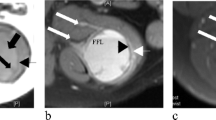Abstract
Objective
To describe the imaging features of plexiform fibrohistiocytic tumor and its associated clinical findings.
Materials and methods
An institutional database was searched to identify all patients with a pathological diagnosis of plexiform fibrohistiocytic tumor. The electronic medical record was reviewed for relevant clinical data. Radiologic images of the primary tumor site were reviewed by two radiologists to assess primary, residual, or recurrent tumor with respect to tumor location, size, morphology, MR signal characteristics and enhancement, and involvement of adjacent structures.
Results
Thirteen patients with imaging of the primary tumor site were identified [eight female, five male; mean age, 15.9 years (range, 3–41 years)]. Plexiform fibrohistiocytic tumor typically manifested as a solitary, painless, firm, slow-growing lesion centered in the subcutaneous tissues, with a predilection for the upper extremity or head and neck region. Most tumors had a purely plaque-like or infiltrative morphology at MRI; some demonstrated no round or oval mass. Tumors were predominantly isointense to muscle on T1-weighted imaging and hyperintense on fluid-sensitive imaging, and enhanced after gadolinium contrast administration. Five patients (38%) had residual tumor after initial surgery, resembling postoperative changes. No patient had recurrent tumor. One patient (8%) developed metastases to local lymph nodes and to the lung. No patient died from plexiform fibrohistiocytic tumor.
Conclusions
Plexiform fibrohistiocytic tumor often manifests as a plaque-like or infiltrative process, sometimes without a round or oval mass, most commonly in the subcutaneous tissues of the upper extremity or head and neck region. Residual tumor is often present after initial surgery, and may be indistinguishable from postoperative changes.







Similar content being viewed by others
References
Enzinger F, Zhang RY. Plexiform fibrohistiocytic tumor presenting in children and young adults. An analysis of 65 cases. Am J Surg Pathol. 1988;12(11):818–26.
Moosavi C, Jha P, Fanburg-Smith JC. An update on plexiform fibrohistiocytic tumor and addition of 66 new cases from the Armed Forces Institute of Pathology, in honor of Franz M. Enzinger, MD. Ann Diagn Pathol. 2007;11(5):313–9.
Fletcher CD. The evolving classification of soft tissue tumours—an update based on the new 2013 WHO classification. Histopathology. 2014;64(1):2–11.
Remstein ED, Arndt CA, Nascimento AG. Plexiform fibrohistiocytic tumor: clinicopathologic analysis of 22 cases. Am J Surg Pathol. 1999;23(6):662–70.
Harrill JC, Johnston RS. Plexiform fibrohistiocytic tumor of the foot: a case report. J Foot Ankle Surg. 2014;53(5):635–7.
Ng E, Tandon AA, Ho BC, Chong BK. Characterising benign fibrous soft-tissue tumours in adults: why is it so difficult and what do we need to know? Clin Radiol. 2015;70(7):684–97.
Yalcinkaya U, Uz Unlu M, Bilgen MS, Yazici Z. Plexiform fibrohistiocytic tumor of bone. Pathol Int. 2013;63(11):554–8.
Yeo ED, Chung BM, Kim EJ, Kim WT. Infiltrating angiolipoma of the foot: magnetic resonance imaging features and review of the literature. Skelet Radiol. 2018;47(6):859–64.
Ravi AK, Ram R, Lindberg MR, Pandey T. Diffuse infiltrative neurofibroma: a clinical, radiological, and histological conundrum. Skelet Radiol. 2014;43(12):1773–8.
Lim R, Jaramillo D, Poussaint TY, Chang Y, Korf B. Superficial neurofibroma: a lesion with unique MRI characteristics in patients with neurofibromatosis type 1. AJR Am J Roentgenol. 2005;184(3):962–8.
Chism CB, Crawford L, Tchakarov A, Al-Ibraheemi A. Beckmann NM. PTEN hamartoma of the soft tissue: the initial manifestation of an underlying PTEN hamartoma tumor syndrome in a 4-year-old female. Skelet Radiol. 2017;46(11):1591–5.
Yoo HJ, Hong SH, Kang Y, et al. MR imaging of myxofibrosarcoma and undifferentiated sarcoma with emphasis on tail sign; diagnostic and prognostic value. Eur Radiol. 2014;24(8):1749–57.
Lefkowitz RA, Landa J, Hwang S, et al. Myxofibrosarcoma: prevalence and diagnostic value of the “tail sign” on magnetic resonance imaging. Skelet Radiol. 2013;42:809–18.
Lee HJ, Im JG, Goo JM, et al. Peripheral T-cell lymphoma: spectrum of imaging findings with clinical and pathologic features. Radiographics. 2003;23(1):7–26.
Antonescu CR, Zhang L, Nielsen GP, Rosenberg AE, Dal Cin P, Fletcher CD. Consistent t(1;10) with rearrangements of TGFBR3 and MGEA5 in both myxoinflammatory fibroblastic sarcoma and hemosiderotic fibrolipomatous tumor. Genes Chromosom Cancer. 2011;50(10):757–64.
O’Driscoll D, Athanasian E, Hameed M, Hwang S. Radiological imaging features and clinicopathological correlation of hemosiderotic fibrolipomatous tumor: experience in a single tertiary cancer center. Skelet Radiol. 2015;44(5):641–8.
Gaetke-Udager K, Yablon CM, Lucas DR, Morag Y. Myxoinflammatory fibroblastic sarcoma: spectrum of disease and imaging presentation. Skelet Radiol. 2016;45(3):347–56.
Salomao DR, Nascimento AG. Plexiform fibrohistiocytic tumor with systemic metastases: a case report. Am J Surg Pathol. 1997;21(4):469–76.
Author information
Authors and Affiliations
Corresponding author
Ethics declarations
Conflict of interest
The authors declare that they have no conflicts of interest.
Rights and permissions
About this article
Cite this article
Ghuman, M., Hwang, S., Antonescu, C.R. et al. Plexiform fibrohistiocytic tumor: imaging features and clinical findings. Skeletal Radiol 48, 437–443 (2019). https://doi.org/10.1007/s00256-018-3050-1
Received:
Revised:
Accepted:
Published:
Issue Date:
DOI: https://doi.org/10.1007/s00256-018-3050-1




